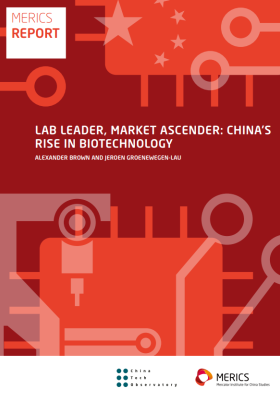

China’s economic policy holds line as growth weakens
MERICS Economic Indicators Q3/2025
MERICS Q3 analysis: China’s policy priorities will not be derailed by economic slowdown in Q3
China’s economy faced growing challenges in Q3 as GDP growth slowed to 4.8 percent. Regardless of mounting external pressures and persistent domestic weaknesses, growth is unlikely to miss the government’s annual target of “around 5 percent”. GDP expanded 5.2 percent in the first nine months, though key macro indicators showed a clear slowdown over the third quarter. After doling out extensive monetary and fiscal support in Q2, policymakers largely took a ‘wait and see’ stance in Q3, though pressure is building for further adjustments.
The increasingly turbulent global environment, marked by the Trump administration’s frequent tariff announcements, export controls, or hikes of port fees, has heightened the uncertainties surrounding global trade. However, China’s leadership has remained unfazed and seems well-prepared to face US pressure, responding swiftly with targeted retaliatory measures. Beijing is leveraging its dominance in critical supply chains, such as rare earths, and its purchasing power in key commodities like soybeans. The anticipated meeting between presidents Xi Jinping and Donald Trump at the upcoming APEC Summit in South Korea will be a key test of whether further escalation in bilateral tensions can be avoided.
Despite the heightened political rhetoric, exports continue to provide a strong boost to China’s economy. So far this year, exports have risen by 6.1 percent, compared to the first nine months of 2024. China’s trade surplus in the first nine months reached 88 percent of last year’s record and is expected to surpass the 1 trillion USD mark by the end of 2025. The export surge begun in 2021, driven initially by the Covid pandemic and China’s global tech expansion, has yet to subside. However, growing discussion of voluntary export controls and international concern at widening trade imbalances suggest this momentum may soon approach its limits.
Although Chinese policymakers tend to attribute the current slowdown to the challenging external environment, it is largely driven by entrenched domestic factors. The real estate downturn and weak household consumption are the outcomes of China’s policy choices, and thus self-inflicted. The government acknowledges these challenges and has tried to counter them with new programs to support consumption, with limited impact so far. The 19-point plan to boost services consumption launched in September is the latest in a series of similar initiatives. Recent efforts focus on raising incomes through higher minimum wages and lowering social security costs, including childcare. The aim is to alleviate immediate pressure points, but a consumption-led recovery backed by large-scale government stimulus remains unlikely.
The Fourth Plenum, held October 20–23, set China’s future economic and social policy priorities, finalizing them for inclusion in next year’s 15th Five Year Plan. The renewed emphasis on strengthening consumption seeks to provide additional economic support ahead of an expected export slowdown next year. However, the focus remains on optimizing China’s technology and innovation sectors, which are seen as central to China’s long-term strategy. Rather than signaling a major policy shift, the Plenum reaffirms the leadership’s confidence in its current course, which it views as the right medium to long-term approach to navigating a period of global uncertainty.
The MERICS China Confidence Index measures household and business confidence in future income and revenues. The index is weighted between household and business indicators. It includes the following indicators: stock market turnover, future income confidence, international air travel, new manufacturing orders, new business in the service sector, urban households’ house purchase plans, venture capital investments, private fixed asset investments and disposable income as a share of household consumption. All components have been tested for trends and seasonality.
The MCCI was first developed in Q1 2017.
![]() Hover over/tap the charts to see more details.
Hover over/tap the charts to see more details.
Exhibit 1
Macroeconomics: GDP growth stays stable in volatile global environment
Exhibit 2
![]() Hover over/tap the charts to see more details.
Hover over/tap the charts to see more details.
Exhibit 3
- China’ GDP expanded at a steady pace in Q3, in a volatile external policy environment shaped by uncertainty in relations with the US. Meanwhile, domestic challenges include overproduction and weak consumption. Even so, GDP grew by 4.8 percent in Q3, slightly lower than 5.2 percent in the June to August period, but broadly in line with expectations. Growth for the first three quarters averaged 5.2 percent, indicating the government’s 2025 growth target of around 5 percent is likely to be met.
- No sector was spared the broader slowdown in Q3, as economic headwinds intensified. Manufacturing growth continued to outperform other parts of the economy; it eased gradually to 6.3 percent year-on-year over the quarter but still outpaced the services sector (see exhibit 1).
- As in the previous quarter, the construction sector was the biggest drag on the economy, contracting yet further from 0.6 percent in Q2 to -2.3 percent in Q3. Real estate activity is persistently weak, and the government is also holding back on new infrastructure projects.
- Gross capital formation’s share to GDP growth fell from 24.7 percent in Q2, down to 18.9 percent in Q3, reflecting a slowdown in investment. However, the slowdown in fixed asset investment (see investment section) would normally suggest a sharper impact on growth, raising some questions about data consistency.
- Policy contradictions may become more pronounced as it gets increasingly challenging to maintain economic stability, with key growth drivers, particularly manufacturing, investment, and exports, likely to lose momentum. Further adjustments to economic policy are likely by the end of the year as the government prepares for the year ahead.
What to watch: The government will need to find a balance short term stabilization and the pursuit of medium-to-long term objectives within the 15th Five Year Plan, which will be published early 2026.
Business: Manufacturing serves as a bulwark of growth momentum in Q3
Exhibit 4
![]() Hover over/tap the charts to see more details.
Hover over/tap the charts to see more details.
Exhibit 5
- Industrial production kept humming in Q3, bucking China’s broader economic slowdown. After slowing in July and August, value-added industrial output grew by 6.5 percent in September year-on-year, powered by manufacturing (up 7.3 percent) and especially high-tech manufacturing (up 10.3 percent). Manufacturing remains central to China’s economic planning, so policy support will stay strong.
- Private firms’ output growth gradually declined in Q3, slowing to 4.6 percent in September from a year-high of 8.2 percent in March (see exhibit 3). State-owned firms picked up the slack, as output growth climbed to 6.5 percent in September from a year-low of 2.9 percent in April.
- China’s automotive sector is benefitting from healthy demand at home and abroad. Output growth jumped to 16 percent in September, coinciding with robust year-on-year growth in exports (20.5 percent) and domestic sales (6.6 percent). This helped the sector to recover from a decline in profits of 12.5 percent year-on-year during January to May. By August, year-to-date profits had reached parity.
- A slowdown in EV output is too early to contribute to policies to counter ‘involution’, the policy buzz word for overcapacity (see exhibit 4). China’s tech strength and solid demand for industrial equipment and inputs helped drive manufacturing gains in September: machinery up 11.3 percent, chemical raw materials up 9.3 percent, and chemical products up 9 percent.
- The shrinking real estate sector and limits on infrastructure investment continue to curb construction-related materials output. The non-metallic mineral products sector, including cement, glass, or sand, grew by just 0.2 percent in September, making it the only one to record negative growth for the year so far.
- September’s manufacturing Purchasing Managers’ Index (PMI) of 49.8 points to more ambivalence and was the sixth consecutive month below 50 (values below 50 indicate pessimism, above optimism). The PMI sub-index for new orders indicates softening demand, but after falling to 49.4 in July it improved to 49.7 in September. These gradual shifts suggest that output will continue to be robust.
What to watch: Volatile US-China trade frictions may continue to dampen sentiment, but China’s leadership is likely to stick with its support for the real economy going into 2026.
International trade and investment: Exports continue to be a bright spot supporting the economy
Exhibit 6
![]() Hover over/tap the charts to see more details.
Hover over/tap the charts to see more details.
Exhibit 7
- Global trade continues to be shaped by rising policy uncertainty. A mix of tariffs, export controls, and embargoes, both targeting China and imposed by China, has created a highly volatile and unpredictable environment. The recurring cycle of renewed tensions and retreats between China and the US, but also other countries, such Australia over iron ore pricing, is generating a more transactional trade regime.
- Despite the heightened political rhetoric, trade data show little evidence of disruption. China’s exports remained resilient, hitting record levels in Q3, albeit helped by some frontloading of orders and trade redirection (see exhibit 6). Measured in USD, Q3 exports grew by 6.3 percent year-on-year, slightly up from 6.2 percent in Q2. September exports rose by 8.3 percent, the fastest pace since March.
- High-tech exports surged to record highs in Q3, reaching 89.8 billion USD in September, up by 11.5 percent year-on-year. They were lifted by strong demand for electronic components including semiconductors, up 33.6 percent, and flat panels, up 13.8 percent, in September.
- China’s auto exports continued to hit new records in Q3. Exports of automobiles, including EVs, reached 37.4 billion USD, up 15.8 percent year on year. But domestic demand for automobiles and related inputs dropped sharply, down 42.4 percent year-on-year. The export surge has intensified trade tensions, prompting China’s government to announce export controls on EVs starting in 2026.
- Nothing yet suggests an abrupt slowdown in Chinese exports. The purchasing managers’ index (PMI) index on new export orders in manufacturing recovered to 47.8 in September after dipping to 47.1 in July. Similarly, cargo ship activity shows no sign of collapsing (see exhibit 7).
- By contrast, China’s imports reflect weak domestic demand and strong industrial capacity. The data got a boost from comparison with low growth in the same period last year, so import growth rose by 7.4 percent in September. However, imports for the first nine months of 2025 were down by 1.1 percent. As a result, China’s trade surplus widened by 26 percent and is on track to exceed 1 trillion USD.
What to watch: A potential meeting between presidents Xi Jinping and Donald Trump during the APEC summit in South Korea early November may help clarify of the direction of bilateral ties.
Financial Markets: Credit growth slows amid lower government borrowing
Exhibit 8
![]() Hover over/tap the charts to see more details.
Hover over/tap the charts to see more details.
Exhibit 9
- After rolling out several policy support measures in the previous quarter, the People’s Bank of China (PBOC) took a more ‘wait and see’ stance over Q3. Although the deflationary environment creates room for a more expansionary stance, the central bank remains cautious about lowering interest rates too far or too quickly. At its Q3 Monetary Policy Committee meeting, the PBOC emphasized existing policy measures should be fully implemented before new ones are introduced.
- Over Q3, total social financing (TSF), an aggregate of credit demand, softened. After growing steadily so far in 2025, TSF growth slowed to 8.7 percent year-on-year, down from a peak of 9 percent in July. The slowdown was mainly due to easing of government bond issuance to 20.2 percent after a rapid increase earlier this year.
- China’s stock market has performed strongly in 2025 (see exhibit 8), underpinned by the robust technology and industrial sectors. Investor sentiment has remained fairly positive despite global trade uncertainties, thanks to expectations of ongoing policy support.
- Households remain cautious about spending as economic uncertainty continues to dampen consumption and loan demand. Instead, household savings deposits have started to rise again this year (see exhibit 9). While still below pandemic-era peaks, new bank deposits rose by 7.4 percent in the first nine months of 2025 compared to the same period last year.
- Some policy support was rolled out in August. Targeted interest subsidies were introduced to stimulate service-sector activity and support broader consumption-driven growth. Businesses in eight key service industries including catering, tourism, and retail became eligible for a one-point interest subsidy on loans.
- But the PBOC is likely to hold off for any substantial adjustments in monetary policy until there is more clarity about the trajectory of US-China relations after an expected meeting between both presidents early November, after which more adjustments could follow.
What to watch: With external uncertainty rising but domestic conditions still manageable, policymakers seem inclined to preserve monetary policy firepower for 2026, in case economic headwinds intensify.
Investment: Manufacturing investment’s slowdown accelerates
Exhibit 10
![]() Hover over/tap the charts to see more details.
Hover over/tap the charts to see more details.
Exhibit 11
- Overall investment initially supported growth, despite a persistent real estate slowdown, as other sectors offset the decline. However, momentum has weakened since June, with total investment contracting by 0.5 percent in September, the first drop since August 2020.
- The struggling real estate sector remains the main drag on investment, weighing heavily on private spending, which has contracted since May. Even excluding real estate, total and private investment slowed sharply in Q3. Growth has more than halved since June (see exhibit 10).
- A sharp slowdown in manufacturing investment was a key factor. Growth was just 4 percent in the first nine months, its weakest rise since December 2020. On a monthly basis, investment was down 1.9 percent in September, compared to 5.1 percent growth in June (see exhibit 11).
- No sector escaped the slowdown in Q3, though with varying intensity. Automotive investment remains a strong pillar of growth, rising by 19.2 percent in the period to September, compared to 22.2 percent at the end of Q2. Textile investment showed a similar pattern, growing by 11.2 percent in the same period, down from 14.2 percent in June. Other sectors started to contract, including medical and pharmaceuticals, down 9.9 percent, and specialized machinery, down 0.7 percent.
- Discrepancies in data raises questions about the real depth of the investment slowdown, or it reflects underreporting by local governments eagerly complying with central government directives to cut overcapacities. Neither the investment contribution to GDP, nor corporate financing indicate a slowdown of the scale seen in Q3.
- But the government has stepped up investment support, signaling concern over the slowdown. New measures include a 10 percent tax credit for foreign firms’ reinvested profits, eased real estate curbs, such as Shenzhen lifting home-buying limits and new infrastructure projects like a 1.2 trillion CNY hydropower plant in Tibet.
What to watch: The government will need to strike a balance between supporting economic growth and its tech priorities and other policy objectives, ranging from local government debt to overproduction.
Prices: Economy fails to shake off deflation despite improvements in Q3
Exhibit 12
![]() Hover over/tap the charts to see more details.
Hover over/tap the charts to see more details.
Exhibit 13
- Deflation remains a challenge for China’s economy, due to both subdued consumption and intense price competition in the industrial sector. The government stepped up efforts to stimulate demand and moved to curb “unhealthy” pricing practices by companies. Q3 brought some improvements but more fundamental progress is still needed before prices show a genuine turnaround.
- The producer price index has been in contraction for three years, but the pace of decline eased in Q3. Prices improved from a 3.6 percent year-on-year drop in June, the steepest monthly fall in two years, to fall by a more modest 2.3 percent in September. The main driver of improvement was manufacturing prices though the contraction in mining and raw materials prices also eased (see exhibit 12).
- A key focus of government attempts to end price wars has been new energy vehicles. So far, the impact appears limited. Factory prices for automobiles fell by 3 percent year-on-year in September, after declining 2.2 percent in June. Battery prices showed only their merest improvement, down 3.9 percent in September compared with a 4.2 percent drop at the end of Q2.
- Consumer prices slipped back into deflation in Q3 after briefly returning to positive territory in June (0.1 percent). By September, the CPI contracted again, by 0.3 percent. So far this year, consumer prices have dropped by 0.1 percent, putting the government’s 2 percent annual inflation target out of reach.
- The CPI decline was mainly driven by falling food prices, as pork prices normalized after supply shortages in 2024 (see exhibit 13). Core inflation (excluding volatile food and energy prices) has performed better, improving gradually this year and rising by 0.1 percent in September. However, the modest increase still leaves the economy close to deflation and confirms demand remains weak.
- Real estate prices in eight of the 70 cities tracked by the National Bureau of Statistics (NBS) increased in September, the highest number since March 2024. This marks an improvement, but the recovery is weak, and the broader real estate slump is unlikely to end in 2025.
What to watch: More price rises across the board before the end of 2025 will be a critical test for the government’s latest policy efforts to curb deflation.
Labor Market: Employment remains under pressure prompting new policy support
Exhibit 14
![]() Hover over/tap the charts to see more details.
Hover over/tap the charts to see more details.
Exhibit 15
- Over Q3 surveyed urban unemployment rose to 5.3 percent in July, the level recorded in July of last year. Record youth unemployment played a key role, as fresh graduates entered the job market (see exhibit 14). Unemployment figures typically peak in summer before they begin to ease again. Nonetheless, there is no escaping the continued pressure in the labor market.
- While government spokespeople often emphasize the challenging external environment, the employment slowdown is primarily driven by domestic factors, including weak demand, skill mismatches and automation and AI. The government continues to roll out targeted support to counteract labor market pressures.
- To help boost consumption and household income in Q3, China introduced a nationwide childcare subsidy at the end of July. The measure provides CNY 3,600 a year for every child under three, exempt from taxes and welfare calculations. More than 20 million families a year are expected to benefit.
- In line with central directives, the Special Action Plan to Boost Consumption issued in March called for mechanisms to “reasonably raise minimum wage standards.” Twenty provinces responded (including Shenzhen, which sets its own rates) with increases or announced adjustments for 2025, more than the 16 provinces that raised minimum wages in 2024. The acceleration reflects nationwide efforts to raise incomes for the country’s lowest-paid workers.
- Consumer sentiment sub-indices measuring household expectations of the labor market inched up over Q3 (see exhibit 15). Income expectations reached their highest level in three years in August but remain well below pre-Covid levels. However, employment sentiment is recovering more slowly.
- Geopolitical frictions are also affecting the labor market, with China introducing the K visa to attract global talent. Effective 1 October 2025, the program targets foreigners in STEM fields from recognized universities or research institutions worldwide.
What to watch: Further labor market support is likely as the 2026 policy agenda and 15th Five-Year Plan take shape.
Retail: Government rolls out new support measures focusing on services
Exhibit 16
![]() Hover over/tap the charts to see more details.
Hover over/tap the charts to see more details.
Exhibit 17
- The government continues to roll out new support measures to boost consumption and encourage household spending. Subsidized consumer loans introduced by the Ministry of Finance in August underscored government determination to stimulate demand and support the broader economy. The retail sector re-mains stubbornly weak, despite frequent programs to encourage consumer spending.
- After a healthy start to the year, retail spending peaked at 6.4 percent growth in May, then slowed during four consecutive months. By September, retail sales had expanded by only 3 percent year-on-year, on a par with the growth rate recorded in November 2024.
- In September, the Ministry of Commerce announced new measures to boost service consumption, which suggests the government is looking for fresh tools as earlier trade-in programs lose momentum. For example, sales of household electronics surged by 53 percent in May following trade-in initiatives but plunged during Q3, rising only 3.3 percent year-on-year in September (see exhibit 16).
- Consumer goods sales remain the weak spot. After a regulatory crackdown on official spending on food and beverages, growth in September dropped to 0.9 percent year-on-year, the lowest level since December 2022 in the middle of China’s Covid pandemic restrictions. By contrast, online sales and, to a lesser extent, services improved over Q3 (see exhibit 17).
- The eight-day National Day holiday was seen as an important indicator for household spending. The number of domestic tourists rose by 16 percent compared to last year, while spending was 15 percent higher. However, per capita spending remained flat at 911 CNY per capita, compared to 916 last year.
- Most importantly, household sentiment remains weak. Consumption willingness, a sub-index of the National Bureau of Statistics’ consumer confidence index, slipped over Q3. The index fell to 94.7 in August (values below 100 indicate pessimism), backtracking on a gradual improvement over the past 12 months. It remains an uphill battle to get consumption on a more solid footing.
What to watch: A new emphasis focusing on structural issues in social security that are holding back consumption would signal growing importance by the leadership.

